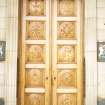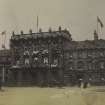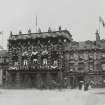Edinburgh, 42 St Andrew Square, Royal Bank Of Scotland
Bank (Financial) (20th Century)
Site Name Edinburgh, 42 St Andrew Square, Royal Bank Of Scotland
Classification Bank (Financial) (20th Century)
Alternative Name(s) National Bank; Excise Office; Dundas House
Canmore ID 52170
Site Number NT27SE 152
NGR NT 25714 74077
Datum OSGB36 - NGR
Permalink http://canmore.org.uk/site/52170
- Council Edinburgh, City Of
- Parish Edinburgh (Edinburgh, City Of)
- Former Region Lothian
- Former District City Of Edinburgh
- Former County Midlothian
NMRS REFERENCE:
Clearing House
PLANS:
Dick Peddie & MacKay, Edinburgh reconstruction
Bin 17, Bag 2 Dick Peddie & Walker Todd 1929
EXTERNAL REFERENCE
Scottish Record Office
Petition from T. Council to Treasury. It asks for a grant of the Excise Office and Ground (in St Andrews Sq.) as a new site for the High School.
1823 GD51/5/127/1-2
Excise office and Grounds in St Andrews Square. Plan of area. Articles of Sale. Letters.
members of the New Club express interest in the Sale Articles and Conditions of Sale "All and Whole that piece of ground lying near Multrisshill" cause Town Council to withdraw its offer. They had hoped to acquire it for High School.
1823-1825
Correspondents: Lord Elcho & others
Messrs. Spottiswoode & Robertson, London
Henry W. Vincent, Treasury
Baillie William Blackwood, Edin.
Plans approved Nov 1936 Occupied June 22nd 1942
Architect: Sir William Chambers 1772-77 (house of Sir Laurance Dundas)
James Byers- designs for chimney-pieces 1770 and proposed new house
Project (1997)
The Public Monuments and Sculpture Association (http://www.pmsa.org.uk/) set up a National Recording Project in 1997 with the aim of making a survey of public monuments and sculpture in Britain ranging from medieval monuments to the most contemporary works. Information from the Edinburgh project was added to the RCAHMS database in October 2010 and again in 2012.
The PMSA (Public Monuments and Sculpture Association) Edinburgh Sculpture Project has been supported by Eastern Photocolour, Edinburgh College of Art, the Edinburgh World Heritage Trust, Historic Scotland, the Hope Scott Trust, The Old Edinburgh Club, the Pilgrim Trust, the RCAHMS, and the Scottish Archive Network.
Field Visit (27 March 2002)
Coat of arms composed of a shield decorated with St Andrew and his cross. To the dexter side of the cross is a wheat sheaf, to the sinister side is a sailing ship. Above the shield is a helmet with raised barred visor. Above that is the order of the Thistle and inscription. The shield is supported by two lions rampant.
Inspected By : T.S
Inscriptions : On order of the Thistle : NEMO ME IMPUNE LACESSIT [ no one provokes me with impunity]
On banner below coat of arms: IN PATRIAM FIDELIS
Signatures : None
Design period : 1936
Information from Public Monuments and Sculpture Association (PMSA Work Ref : EDIN1381)
Field Visit (27 March 2002)
Carved Scottish coins - on N.door from top to bottom ( in square panels)
1. St Andrew (from the time of James V), reverse side - a St Andrew's cross encircled by a crown (centre), between an I ( dexter) and an R ( sinister) a thistle (above ) and a fleur de lis (below). In the corners of the panels are roses.
2. Ecu or Crown (from the time of James V), reverse side - a cross fleury with a quatrefoil in the centre, a thistle-head in each angle. In the corners of the panel are roses.
3. 1937 Scottish Shilling (from the time of George VI), reverse side - a lion sejant, wearing a crown and holding a sword in its right paw, a sceptre in its left; sitting on a crown. To the dexter side is a shield with a St Andrew's Cross, to the sinister side is a thistle in the shape of a shield. In the corners of the panel are thistles.
4. Thistle Noble (struck 1588, in the time of JamesVI), obverse side - a ship with a flag at each end, on the sea. In the centre of the ship are the arms of Scotland crowned. In the corners of the panel are shells.
5. Demy or Lion (from the time of James I), reverse side - a small St Andrew's Cross between 2 fleurs de lis, enclosed within a figure composed of 6 curves bending inwards, each point terminating in a fleur de lis. In the bend of each curve is a quatrefoil. In the corners of the panel are berries [?]
On S. door, from top to bottom:
6. Groat (from the time of James V), reverse side - the arms of Scotland, surmounting a cross fourchee. In the corners of the panel are acorns,
7. Crown (struck 1561, in the time of Mary), reverse side - 4 Ms in the form of a cross, crowned, with a thistle between each, an 8-pointed star in the centre. In the corners of the panel are roses.
8. Unicorn (from the time of James IV) obverse side - a unicorn with a crown around i's neck supporting a shield, decorated with the arms of Scotland, on its off fore leg. In the corners of the panel are thistles.
9. Noble (from the time of David II), reverse side - a cross fleury within a double tressure of 8 curves. A lion passant guardant and a crown are in each angle. In the corners of the panel are roses.
10. Sword and Sceptre Piece (struck 1601, in the time of James VI), reverse side -a sword and sceptre crossed in Saltire, between 2 thistle heads (each side), a crown (above) and the date (below). In the corners of the panel are berries [?]
Inspected By : T.S
Inscriptions : On coins- 1. St Andrew: HONOR REGIS IVDICIVM DILIGIT ( = the king's power loveth judgement)
2. Ecu or crown: CRVCIS [ARMA] SEQV[A]MVR ( CRUCIS ARMA SEQUAMUR = Let us follow the arms of the cross)
3. 1937 shilling : FID:DEF:IND:IMP around coin (abbreviation of FIDEI DEFENSOR = Defender of the Faith, and INDIAE IMPERATOR = Emperor of India); 19 37 in centre of coin; KG in centre of coin.
4. Thistle noble: IACOBVS. 6. DEI. GRATIA . REX. SCOTORVM (= James V1 by the Grace of God King of Scots).
5. Demy or Lion: S[A]LVVM. F[AC]. POPVLVM:TVVM. DN[B] (SALUUM FAC POPULUM TUUM DNB = O Lord save Thy people)
6. Groat : OPPI DV . EDINBVRGI (OPPIDU EDINBURGI =Town of Edinburgh).
7. Crown : EXVRGAT . DEVS . ET . DISCIPENTVR . INIMICI . 1561 (Let God arise and His enemies be scattered)
8. Unicorn : IACOBVS 4: DEI. GRA . REX. SCOTORVM. (= James IV by the Grace of God King of Scots)
9. Noble: I[HC] . [A]VT[E]M . TR[ANC]I[EN]S . P. M[E]DIVM . ILLORVM . IB[A]T ( IHC AUTEM TRANCIENS P. MEDIUM ILLORUM IBAT = But Jesus passing through their midst went his way)
10. Sword and sceptre piece: SALVS.POPVLI.SVPREMA.LEX (= the safety of the people is the supreme law. 1601 ( at the bottom of centre of coin).
Signatures : None
Design period : 1936
Information from Public Monuments and Sculpture Association (PMSA Work Ref : EDIN1382)
Field Visit (27 March 2002)
Two heraldic panels (both identical) decorated with a shield on a mound, decorated with the top half of a lion rampant, painted white on a red background (top sinister); the top half of a lion rampant, painted red on a white background (top dexter); a thistle flanked by 2 moons on a blue background (bottom). Shield supported by a horse (dexter) paintd white with a plume on its head and its body decorated with oak leaves, and a deer (sinister) painted blue, with antlers, its body decorated with moons and stars.
Inspected By : T.S
Inscriptions : On banner at top of panels : FIRM
Signatures : None
Design period : 1936
Information from Public Monuments and Sculpture Association (PMSA Work Ref : EDIN1383)
Standing Building Recording (18 February 2016 - 19 February 2016)
NT 25711 74080 A historic building survey was carried out, 18–19 February 2016, of the former Royal Bank of Scotland headquarters building in advance of development work. The former bank building was constructed in the 1930s (replacing a previous bank building on the site built in the 19th century) to a design by Leslie Graham Thomson and Arthur Davis in a palazzo style. The interior of the bank was designed by Thomson and Connell and is thought to have been similar in style (and in keeping with the neo-Classical style of the building) as its predecessor. In 1958, the bank changed its name to the National Commercial Bank of Scotland, and
banking operations extended to the buildings opposite at West Register Street. In 1969, it became part of the Royal Bank of Scotland, becoming the bank’s head office in 1973. A multi-bay eight-storey building, the bank contains two basement levels with service rooms and two bullion rooms
to each level with a large and complex ventilation system still in situ. This rises to the main banking floor accessed from the main entrance, ascending to a further five floors of offices and other service areas for the staff at the bank. There are a few rooms, mostly on the second and third floor that retained their original furnishings finished to a high standard. Most notably, on the second floor, there is a large panelled Board Room, and the Manager’s Luncheon Room and adjacent Smoking Room on the fourth floor. The original character of these rooms will be maintained and reflected the senior position and importance of the manager’s at the bank.
Archive: NRHE (intended)
Funder: Chris Stewart Group
Diana Sproat and Gemma Hudson – AOC Archaeology Group
(Source: DES, Volume 17)














































